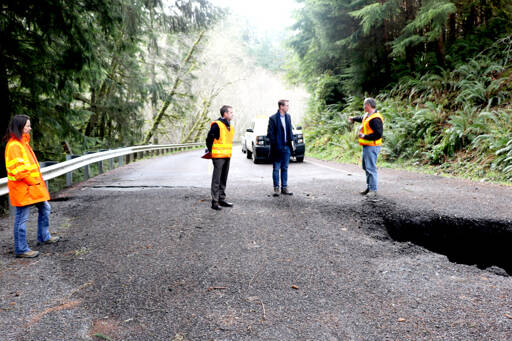The state Department of Transportation hopes to reopen Highway 112 early next year following a landslide that has cut off travel to the West End.
“We expect to have a contract out by the end of January, add at least eight weeks to that, and that’s a rough estimate of when we might have this restored,” said Steve Roark, Olympic Region Administrator for WSDOT.
The landslide occurred Nov. 14 following severe rain and flooding events in the region. The roadway connects coastal communities like Clallam Bay and Neah Bay to the rest of the North Olympic Peninsula.
U.S. Rep. Derek Kilmer, a Gig Harbor Democrat who represents the 6th Congressional District, including the Peninsula, joined DOT team members at the site Monday near milepost 32.
Site repair depends on a number of things, primarily stabilization of the area to allow for DOT crews to work safely as well as the approval of emergency permits and funding from the state, officials said.
State officials also said the cost of the repairs will be determined once the scope of work designs are completed.
While a temporary bypass route around the slide has been established for critical access using a private two-lane road, the highway remains an essential road for residents on the West End.
Kilmer asked state officials about how a recently passed $550 billion infrastructure bill could help them.
“I’m curious how the state DOT looks at the federal infrastructure bill, both from the standpoint of roads and bridges dollars, but there’s that separate $47 billion pot that, for all the bad climate stuff, do you look at that and say, like, ‘Oh we might be able to tap into some of that for armoring?’ ” Kilmer asked.
The bill has set aside about $110 billion for roads and bridges projects. Washington state could receive about $4.7 billion in that funding for roads and $610 million for bridges, Kilmer said.
Roark said there is not so much a need for armoring but for addressing the landslides that occur along the 112 corridor.
“We’ve got a lot of hot spots in this corridor that have us out here every five or six years, so, from a resiliency standpoint, there are things to do here,” he said. “Right now, we get emergency funding. We do what we can to get the road open.”
Highway 112 sits on an active slide zone, with slides happening every 10 to 20 years. The most recent occurred in December 2020, and it shut down eight miles of the highway near the Pysht River.
The state will work with the Federal Highway Administration for emergency relief funds to build some resiliency improvements into the slide area that will hopefully protect it and minimize slide damage in the years to come, state officials said.
“This will be paid for with the emergency relief funds … which allows for some betterment, and we will work with FHWA, but you know there’s only so much money, and you can’t a permanent fix with those dollars,” said JoAnn Schueler, assistant regional administrator for Project Delivery with DOT.
Kilmer said he and other congressional representatives in Washington have heard from several constituents throughout the years about infrastructure projects pertaining to roads.
“We are hearing from constituents, not just about this project but about others where we are seeing more and more challenges,” he said. “That’s part of the reason I wanted to come to take a look at this because the infrastructure bill provides both a bunch of federal funds to the state for resilience projects, and if you think about the areas I represent, we have a lot of areas that have resiliency challenges.”



